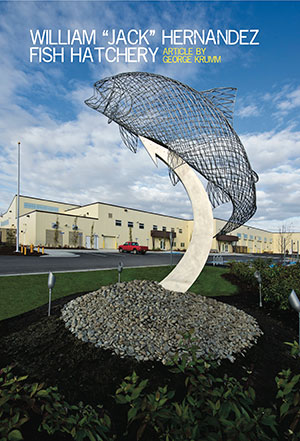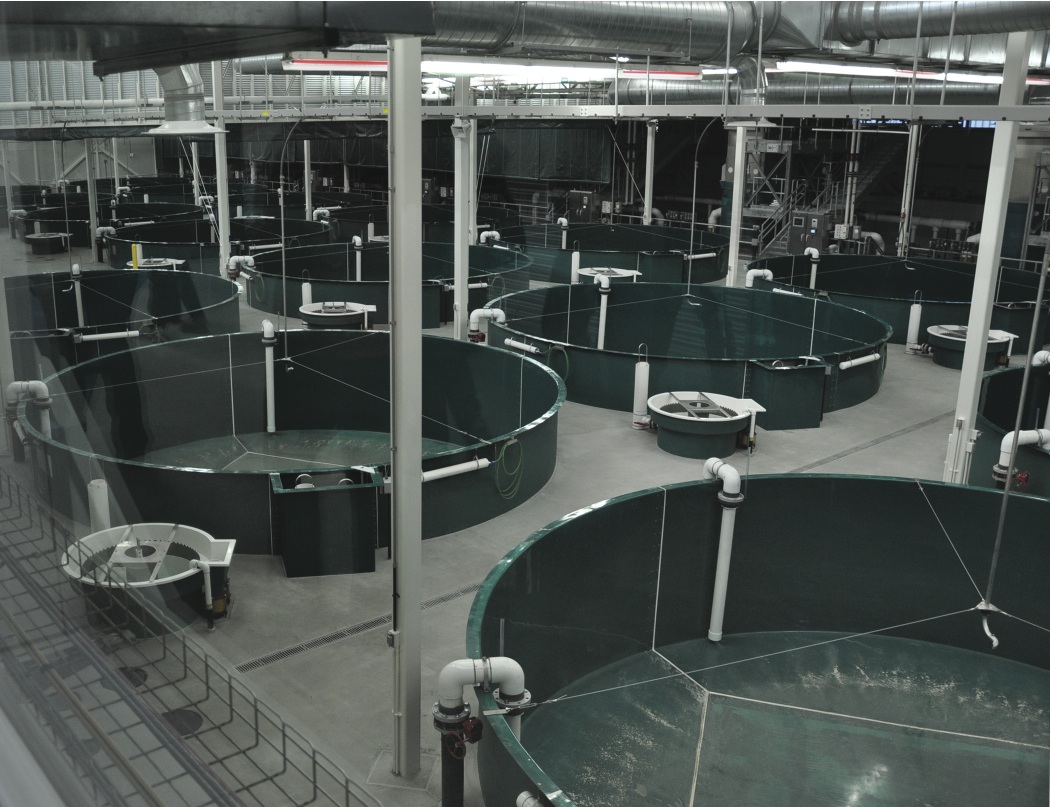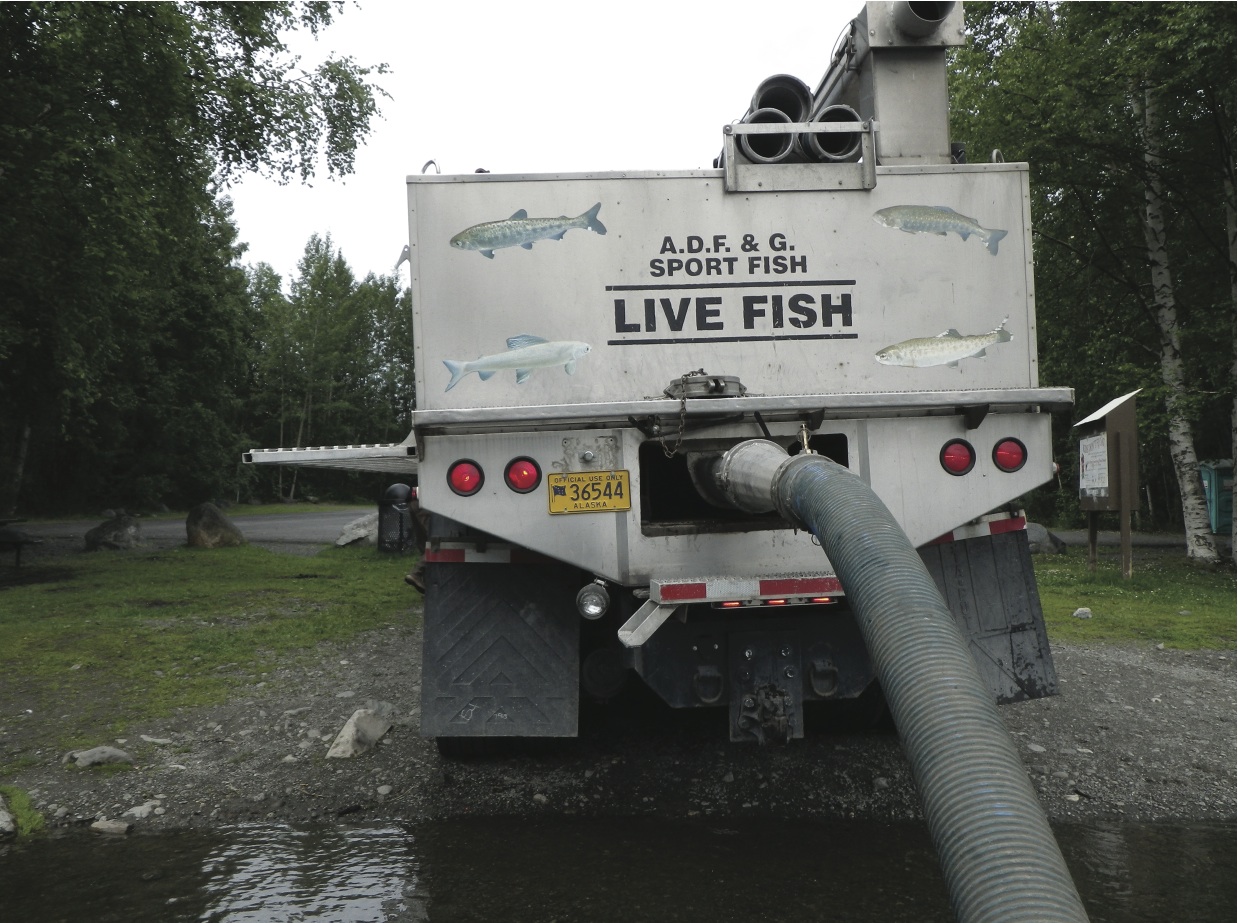
Article by George Krumm
In 2003 and 2005, the Fort Richardson Hatchery and the Elmendorf Fish Hatchery lost their source of heat to warm water due to the closure of the Elmendorf and Fort Richardson Steam Plants. The fish hatcheries depended on the free heat from the plants to raise the temperature of water coming into the hatcheries to accelerate fish growth. The loss of this source of heat significantly impacted the hatcheries’ ability to meet the production demands of the Statewide Stocking Plan.
Being an avid stillwater fly fisherman, I began to notice the effect on some of the lakes I fished in the five years after the steamplants closed. The size of newly stocked catchable trout was much smaller than in the years prior to the steam plant closures. Some lakes were no longer stocked at all, resulting in very slow fishing. Both numbers and size of fish were negatively affected as a result of the steam plant closures, and fishing in some lakes got progressively worse for five years. In fact, 12 of 26 lakes in the Anchorage bowl and 13 of 30 lakes in the Mat-Su Valley that were scheduled to receive catchables each year received none since 2006. Today with the new hatchery, ‘catchables’ are once again eight inches long or larger and numbers produced are once again in accordance with the Statewide Stocking Plan.

Fortunately for southcentral Alaska anglers, the state’s new William “Jack” Hernandez Fish Hatchery came online in 2011 and the first catchable fish were stocked from it in 2012. As of this issue of Fish Alaska, the hatchery is in full production, and for the first time since 2006, ADF&G hatcheries will be able to meet or exceed all requirements of the Statewide Stocking Plan.
The hatchery features new, state-of-the-art water recirculation technology that makes the loss of the old steam plant less significant. What’s more, the entire facility is indoors. It is a model of efficiency.
Here are a few examples of the advantages of this new technology: Extreme efficiency from a water-use and heating standpoint; separate sections isolate other parts of hatchery from contamination in the case of disease or pollution; stable, year-round water temperature for optimal fish growth; computerized, programmable feeding system. Additionally, circular tanks with current provide optimum oxygen saturation, resulting in little wasted space compared to old raceway technology; fish are pumped directly from the tanks to the stocking truck with no handling, resulting in almost no mortality; zero predation—outdoor hatcheries at Fort Rich suffered three- to five-percent mortality primarily due to birds such as ducks and magpies. The hatchery also uses much less water than the old facilities. Currently, the new hatchery is operating at about 1,400 total gallons per minute. The old facilities routinely ran over 10,000 gallons per minute for similar production levels.

I recently had the pleasure of touring the new facility with hatchery manager Andrea Tesch. Andrea has a wealth of experience including raising tilapia in West Africa to raising all five species of Pacific salmon on Esther Island to managing the Fort Richardson hatchery. The hatchery raises Chinook (king) and coho (silver) salmon, Arctic char, grayling and rainbow trout. I’d prepared some questions for Andrea and the following is a summary of those questions and answers.
FA: How long does it take to produce catchable rainbows now compared to 2007?
Andrea: Now we produce catchable rainbows that average 120 grams (4.2 ounces) in one year. Some will be larger, some will be smaller. After the power plant shut down it took three years to get fish close to 100 grams (3.5 ounces).
FA: How long does it take to produce fingerlings?
Andrea: Fingerling production hasn’t changed very much. Fingerlings are still produced in two to three months after being removed from the incubators and placed in tanks (ponding).
FA: Has the size of catchables and fingerlings increased with the new hatchery?
Andrea: Yes—king salmon catchable production in particular has benefited with larger, healthier fish and no jacks. These are likely the best king catchables ever produced by state fish hatcheries. The grayling catchable program has been resurrected after being dormant since 2003. 2013 will be the first time since 1998 that we have produced grayling over 100 grams. Fingerlings of all species are also being released at three- to five grams, instead of two- to three grams. Starting in 2014 rainbow fingerlings will be bigger, earlier, due to advanced egg take timing.
FA: How many catchables will you produce at full production now compared to 2007?
Andrea: Fish numbers are similar to what they were before the power plants shut down. Fish size is the same or slightly larger than they were in the power plant days and significantly larger than they were in the 2007 to 2011 timeframe. We are at full capacity in accordance with the Statewide Stocking Plan now. We have the ability to increase stocking by 50%. This means we could exceed the current Statewide Stocking Plan if the budget allowed.
FA: Has the ratio of triploids to diploids changed with the new hatchery?
Andrea: Triploid numbers have gone up, and 2013 will be the first year that nearly all of our lake releases will be triploid. 100% of the kings, char and grayling will be triploid and nearly all of the rainbow trout and land locked coho will be triploid. This is not really attributable to the new hatchery though, as we were moving in that direction anyway due to the direction provided by the Statewide Stocking Plan and fine-tuning of our triploid induction techniques.
FA: Due to the production deficit caused by extremely cold water since 2006, what percentage of the Statewide Stocking Plan could not be met between 2007 and now?
Andrea: Depending on what you look at (program, biomass or numbers) we had lost between 30% and 50% of our production capacity. For non-category-one lakes, king catchables and grayling catchables are equal to 20% of lake-stocking requests by numbers of fish and those programs were either nonexistent or significantly reduced during that timeframe.
FA: Since fish are in fact released at a larger size is survival expected to be higher?
Andrea: Yes—larger, healthier, more robust fish are assumed to have better survival rates. Fish health has also improved significantly by bringing production indoors, where we can control all elements and have no predation issues.
FA: Since fish are released at a larger catchable size, do you think the maximum attainable size in a given body of water might be larger? Such as, if you release a three-year-old rainbow at seven inches, compared to a one-year-old rainbow at ten inches, is it reasonable to assume the latter will have the potential to grow much larger assuming it dies of old age?
Andrea: The short answer is yes. But in most cases catchable fish are stocked into lakes with high harvest rates and relatively low forage levels. We rarely see much growth between stocking and harvest. In locations with lower harvest pressure and high forage density we primarily stock fingerling.
FA: What is the difference between water temperature inthe new hatchery and water temperature at the hatcheries in 2007?
Andrea: Water temperatures are now similar to what they were when we benefited from free heat from the power plants; however, because we are recirculating 95% of the water in our large rearing tanks, not as much needs to be heated. Culture systems with no heat stay at 6- to 7 degrees Celsius (43- to 45 degrees Fahrenheit), nearly double the temperature of the incoming well water.
FA: How does the current speed in the raceways of old compare to the circular tanks of today, and does the greater current speed result in better fitness?
Andrea: The velocity in the circular tanks is up to ten times that of a linear raceway, but the circular tanks also have varying velocities. The velocity near the center of the circular tanks is much slower than the velocity near the edges. The fish can choose the current that they are comfortable in. The higher velocity is assumed to contribute to better fitness, and also results in better water mixing and water quality throughout the tank.
FA: Are the best years of southcentral Alaska’s stillwater fishing ahead of us due to the new hatchery?
Andrea: Yes! Now that we can control water temperature and other environmental factors we expect to see regular improvement in our ability to achieve survival, size and stocking goals.
Andrea’s last answer was music to my ears. For those of you who think the numbers of fish in some of our lakes has been down the last several years, you’re correct. However, that’s all about to change. I talk a lot about the hatchery’s impact on stillwater fishing, but the hatchery will also help with the enhanced salmon fisheries in Southcentral—Ship Creek and Bird Creek are prime examples, though not the only ones.
Tours are available and I highly recommend visiting this state-of-the-art, well-run facility. The visitor area is open to the public seven days a week from 8 a.m. to 4 p.m.
George Krumm is editor of Fish Alaska & Hunt Alaska.
William “Jack” Hernandez Fish Hatchery originally appeared in the May 2013 issue of Fish Alaska.
